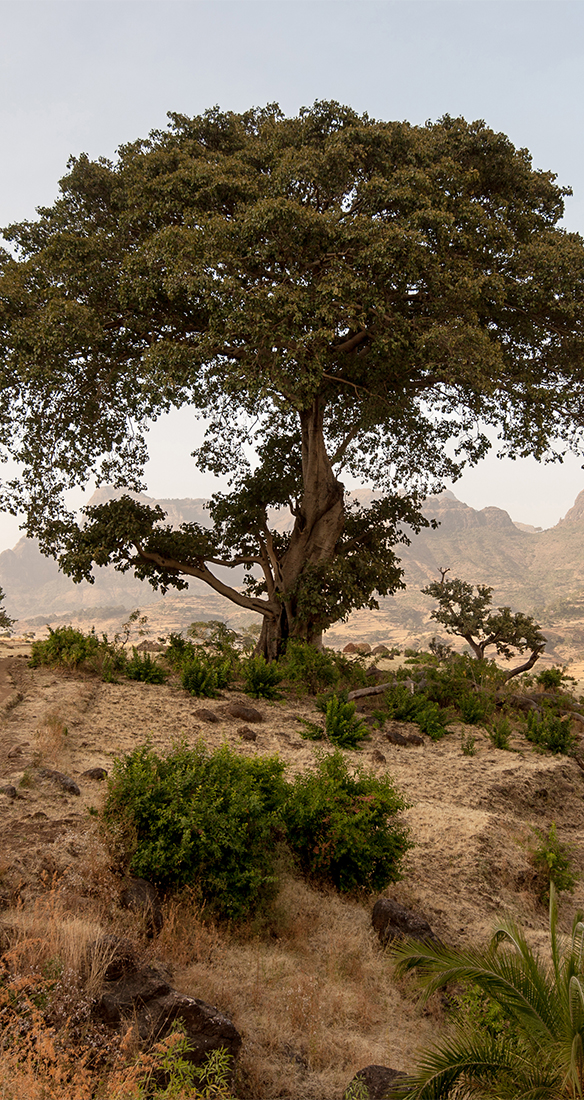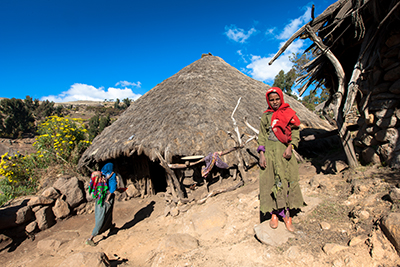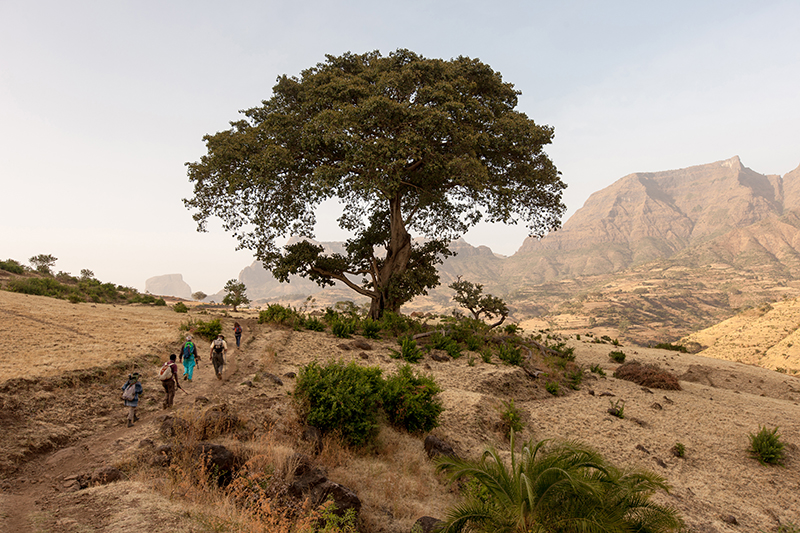
THE HISTORY OF Ethiopia is as fascinating as its topography. Situated in the Horn of Africa, the country is landlocked, and it’s the most populous in the world: 90 million inhabitants and counting. Exotic tales of the Queen of Sheba and the mysterious Ark of the Covenant, African despots, and the exploits of Emperor Haile Selassie continue to fascinate and enthrall, all spanning a rich history that goes back to the second millennium BC. Yet much of what we know of the country is muddied by press that, too often, focuses only on the harrowing past and present famines, which seems a shame for a nation inhabited by the most smiley people on the planet.
Much to the surprise of visitors, most of the country is lush, fertile and green, particularly in the rainy seasons when the storms lash the Simien Mountains in the north, carpeting the ground in exotic and rare species of plants. Any first-timer should head to these mountains for the spectacular otherworldly scenery and breathtaking natural beauty: high plateaus, deep escarpments, heather forests and jagged mountain peaks roll into the distance in a landscape shaped by nature and traditional agriculture. And the shapes are extraordinary — you can understand why they have often been described as “the chess pieces of God.”
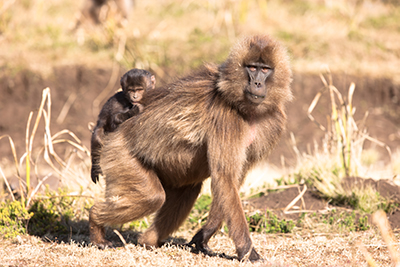
The mountains are some of the highest in Africa (Ras Dashen sits at 14,903 feet) but most come not to climb but to marvel at the biosphere, and with so many endemic species you can take your pick — from the fragrant and fragile white rose of Abyssinia to the jazzy headdress of the impressive giant lobelia. If you are into primates of any sort, you will delight in watching the gentle gelada in its natural habitat. Only found in the Ethiopian Highlands, the gelada is also known as the bleeding heart monkey, so called because of a pink heart-shaped patch on its chest. The males sport an enviable “just stepped out of a salon” hairstyle with blowndry swishy highlights, which they proudly show off to the females. Geladas have intriguing habits and characteristics, and one can sit and watch them for hours — scratching, eating, conversing, fighting, chasing and generally behaving much like us. With strong social ties, they are among the few mammals known to honor their dead, carrying the bodies to the cliff ledges (where they retreat each night) as a safe place out of reach of predators. The primates have developed strong fingers to climb down the vertiginous cliffs. There are strict rules against feeding the geladas, who mostly choose to ignore us two-legged cousins.
Humans and animals lead a wary coexistence in the highland area that forms the Simien Mountains National Park. The people living on the outskirts of the park area eke out a farming existence clearly demarcated on the land where they graze their cattle. Walking through these landscapes you will come across clusters of little rickety huts where large families live inside on one side, their livestock on the other, and sometimes even a beehive or two (used as a source of honey) finds room within the dung-patted walls. Although the residents have very little to give, they’re quick to welcome travelers with a cup of potent coffee made with green fresh-roasted beans. The shot of caffeine is a great way to fortify yourself for heading back out into the thin air to the hiking trail.
The national bread, known as injera, is made from the indigenous grain teff. Once it is pummeled and pounded, the liquid batter is then poured over a hot plate and quickly cooked. Although it doesn’t look appetizing, you come around to the taste after rolling the bread up in your fingers and dipping it in a variety of spicy stews and lentil curries. The combination makes for a substantial and interesting meal to share around the table.
If you join an organized trek you might have a chef, and recently our small trekking group had a very good one — so good his name actually was Fantastic. A slender, handsome boy with an impish grin, he managed to conjure up quite delicious three- and four-course meals of hearty soups, salads and stews from inside a smoky hut kept (relatively) shipshape by a team of busy helpers, including a sous chef and two kitchen skivvies. We also had three happy scouts: Tiruneh, Werke and Teshager, whose wide smiles lit up their faces; they were there to protect us from thieving bandits and prowling leopards and proudly held their Kalashnikovs close by their sides at all times. They slept outside — often in a seated position — wrapped in thin blankets, keeping watch in the freezing air throughout the night.
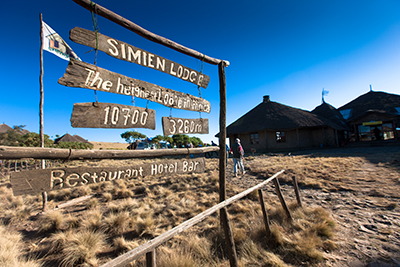
On my trek, composed mostly of British and U.S. citizens ranging in age from 19 to 65, our main guide was Samson, joined by local guide Fanta and the muleteers — a friendly bunch of rabble-rouser boys who looked after the mules and seemed to swell in number as we went along. (At one point there were 13 of them monitoring 19 mules.) To complete the menagerie, we had some farm animals which (I’m sorry to say) we ate en route. They had a good life, though — plenty of fresh air and exercise, and when we realized the sheep was going to be dinner the next night, we sang carols to it; that particular night happened to be Christmas Eve, as Ethiopians celebrate Christmas according to the Julian calendar, on January 7. Nothing went to waste after the butchering; even the head and hooves were used, strung up in a tree at the campsite to encourage the many large and splendid raptors circling overhead to pick at the flesh. And what birds they were: augur buzzards, various eagles and the aptly named majestic bearded vulture, also known as the bone crusher.
Taking in the natural beauty of this region is a one-of-a-kind experience. Each day of a trek reveals something different from the one before, all of it dramatic. You walk above the clouds and through rolling mists watching birds swoop and dive beneath. Campsites are situated in vast plains with rolling hills fanning out behind or on steep ridges with spectacular views of the valleys below. By day you march along narrow trails through landscapes strewn with cactus, stopping for picnic lunches on cliff edges in the company of grazing walia ibex. There are rivers to cross and gorges to wade and thundering ice-cold waterfalls to sit under after the hot and dusty walk. The hiking is challenging but immensely rewarding. Our small team bonded in our roller-coaster exploration of this stunning country. Most who have been here vow to return, for the wonders still waiting to be discovered.
IF YOU GO
HOW TO GET THERE Ethiopian Airlines, the national carrier, flies direct from most major cities in Europe and many cities in the U.S.
PLACES TO STAY Ethiopia does not have a lot of luxury accommodations, but there are a few gems, including the Simien Mountain Lodge, Gheralta Lodge (in the Tigray region) and the recently opened Bale Mountain Lodge (a one-day drive from Addis). The Sheraton in Addis is the best hotel in town; the Hilton Hotel in Addis has quirky character and charm, with a lovely garden and an atmospheric bar.
TRAVEL TIPS
- Make sure you’re up to date with inoculations, and remember that malaria is prevalent below 6,500 feet (primarily in the south).
- It can be cool in the highlands and in the Simien Mountains at night, so pack warm clothes.
- Do bring unwanted clothes and educational materials, as numerous schools and orphanages here gratefully accept donations.
- Come with patience, good humor and your dancing shoes. You’ll be pleasantly surprised how friendly and hospitable Ethiopians are — and how much they love to dance.
For more photos, view the gallery below.
[gtx_gallery]

